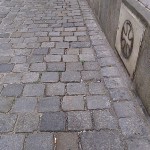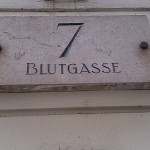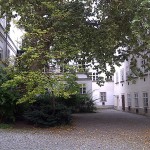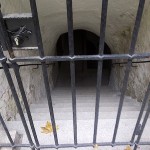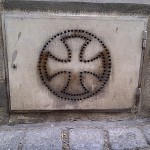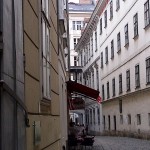Friday the 13th, Blood Lane and the Assassination of the Knights of Templar
This world nis but a thurghfare ful of wo,
And we ben pilgrimes, passinge to and fro;
Deeth is an ende of every worldly sore.
– Geoffry Chaucer, The Canterbury Tales, “The Knight’s Tale”
Behind St. Stephan’s Cathedral, in one of the oldest quarters of Vienna, is a cobblestone, car-free lane called Blutgasse. “Blut” means “blood” and “Gasse” means “lane” or “alley.”
At Blutgasse 9, a passageway leads into a charming courtyard dominated by an ancient tree ascending into the heavens and harboring an equally old cellar stair descending into the bowels of the earth.
The perfect place to encounter legends and myths.
And, of course, Vienna doesn’t disappoint.
The courtyard is Fähnrichshof — fabled as the former headquarters of the Knights of Templar in Vienna and a place where the knights may have hidden their treasures.
But who were the Templar Knights?
Well, the story goes that the Templar Knights were a secret society and eventually an elite military force started by nine French noblemen in 1118 who claimed they would protect pilgrims on their journey to Jerusalem. The King of Jerusalem, Baldwin I, allowed the knights to take up residence in the Tempelberg in Jerusalem, today the Al-Aqsa-Temple, and thus they got the name, the Knights of Templar. But during their stay in Jerusalem, the Templar Knights were doing more than protecting some pilgrims; they were digging beneath the temple for sacred artifacts that had been buried. Eventually they were successful in this endeavor and transported their treasures back to Europe.
Things seemed to be going well for the knights who built cathedrals throughout Europe, grew in number and directly answered to the pope. But then came 1307.
Apparently in 1307 King Philip owed the knights quite a sum of money and decided one way to deal with his dilemma would be to accuse the knights of heresy. So, according to the legend, on Friday, October 13, 1307, King Philip had the knights in France arrested, tortured and killed and ended their time in France. Thus, Friday the 13th became marked as an unlucky day.
The knights were able to transfer their treasures abroad, and some believe these landed with the German Order of Teutonic Knights and the St. John’s Order – both of which had groups in Vienna.
And what were these treasures? The holy grail, the ark of covenant, the head of Baphomet, and more – ended up somewhere but no one knows for sure where.

The Vienna Review had an interesting article on the legends surrounding the Blutgasse. Read “The Knights of Blood Alley” here: http://www.viennareview.net/on-the-town/the-knights-of-blood-alley
Another good resource about the legends of the knights and free masons is the German language book:
Bouchal, Robert, and Gabriele Lukacs. Geheimnisvoller Da-Vinci-Code in Wien Verborgene Zeichen & Versteckte Botschaften. Wien: Pichler, 2009. Print.
Interested in Vienna and legends? Read about the Stock-im-Eisen tree stump, the Holy Lance (Spear of Destiny) and the Last Supper mosaic.
